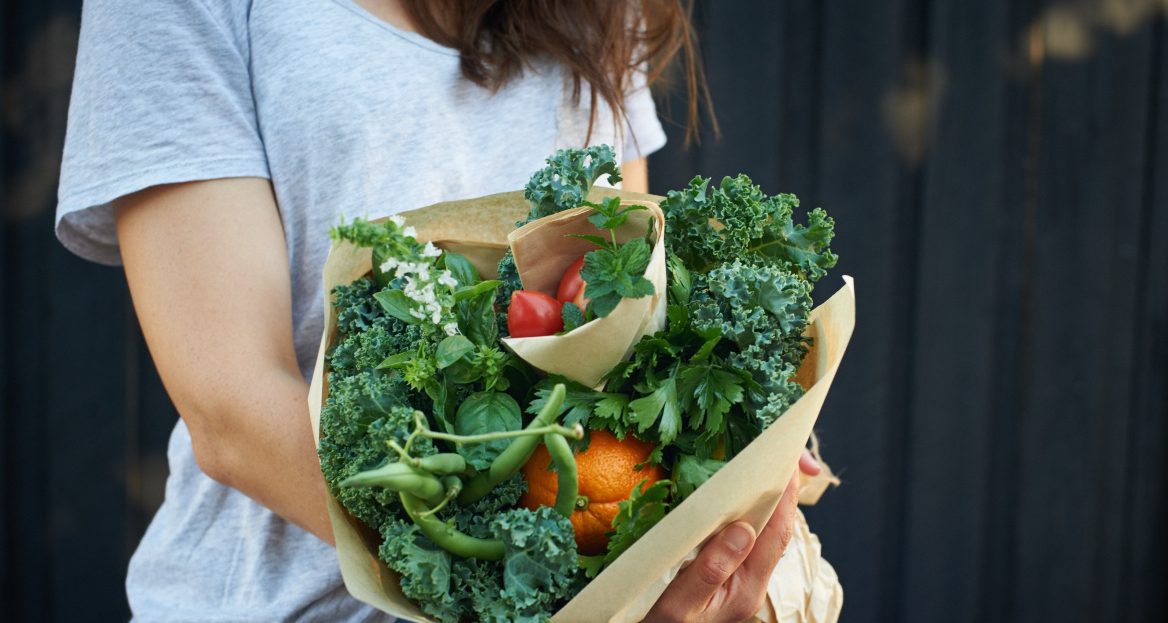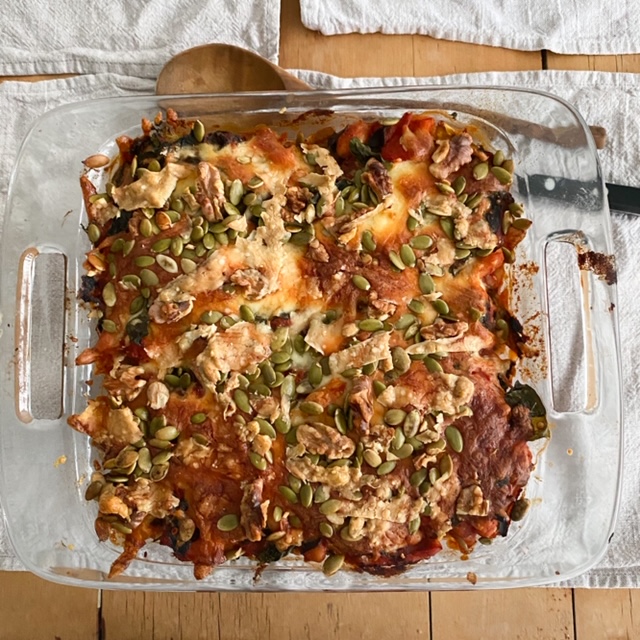Lasagne would have to be one of the most comforting and well-loved meals. This ‘formula’ provides a base recipe that allows you to use any vegetables, nuts, seeds, herbs, and cheeses you like. I like to include legumes in the sauce as they add texture and heartiness. However, you can also use a simple tomato (or meat sauce) if you prefer.
The idea of this formula is to provide a guide for creating a delicious vegetable lasagne using what you have at hand such that after one or two lasagne creations it becomes second nature (and you won’t need to follow the formula anymore).
You need:
- A baking dish (square, rectangular or oval, approx 30cm/20 x 20cm)
- 1 x packet of lasagne sheets (instant or fresh)
- Root vegetables of choice to roast (roughly 2.5 cups worth – e.g. 1/4 of a small Jap pumpkin, sliced) or other e.g. eggplant, capsicum
- Green vegetables of choice to use raw (roughly 2.5 cups worth – e.g. 1 small zucchini, sliced and a handful of broccoli and/or baby spinach)
- Fresh herbs of choice – optional (e.g. parsley, basil)
For the sauce:
- 2 x tinned chopped tomatoes or 1 bottle of passata (or a mix of both)
- Garlic (1-2 cloves), chopped or crushed
- Onion (1/2 brown or red onion) – chopped
- Chilli (flakes or fresh) – optional
- Dried herbs of choice (e.g. one or more of oregano, rosemary, thyme, bay leaf, mixed herbs)
- Olive oil
- A splash of water
- A splash of red wine – optional
Cheeses (one or more of these)
- Mozzarella, sliced or grated or bocconcini – the amount depends on how cheesy you would like your lasagne, I suggest buying 1 small packet of grated mozzarella as this should be plenty (especially if using ricotta too)
- Ricotta, fresh or smooth – I suggest using 100-200g (you don’t have to use ricotta though)
- Parmesan – grated, for adding on top
For crunch
- Nuts (e.g. walnuts, almonds or pecans) – a few handfuls
- Seeds (pepitas or sunflower or both) – a handful or two
To make:
- Preheat oven to 180 degrees Celsius fan-forced.
- Prepare Vegetables: Chop and roast the root vegetables you would like to use. I love using pumpkin as it provides a moreish sweetness. Slice pumpkin/sweet potato/beetroot/parsnip/turnip, lay on a baking tray (on baking paper) and roast on high (~180 – 200) until cooked. Slice/chop your green vegetables or if using spinach or another leafy green, wash, and chop.
- Make your sauce: In a pan, add chopped/crushed garlic (and if you like, add chopped onion too) and a splash of olive oil (plus chili if you like) and saute until golden. Add your tinned tomato and/or passata sauce, herbs (dried and/or fresh), salt and pepper and a splash of water or wine, and simmer on low for a few minutes. At this point, add a tin (or two) of drained and rinsed tinned legumes. Allow your sauce to simmer on low for a few more minutes, stirring occasionally.
- Layer your lasagne: have your cheese ready (e.g. grated mozzarella and/or ricotta), your baking tray, your lasagne sheets and greens and once cooked have your roasted vegetables ready to be used. I like to start with a thin layer of sauce so that nothing sticks to the baking dish, then lasagne sheets, then sauce, then roasted veggies, then raw veggies, then ricotta and mozzarella, herbs (e.g. basil leaves), and some nuts. You don’t have to layer in this order but I find this works well. After the cheeses, herbs and nuts, add another layer of lasagne sheets and then start again.. sauce, roast veggies, raw veggies and so on. I usually include 3 layers of lasagne sheets (first at the bottom, second in the middle and the third on top which I only top with sauce then cheeses). With the final top layer of cheese, I like to add mozzarella, parmesan, nuts and seeds.
- Ensure there’s enough liquid in your lasagne, especially if using instant lasagne sheets (i.e. if your sauce isn’t super saucy, I suggest adding a few splashes of water to your lasagne.
- Bake for 30-45mins, checking at 30mins. Aim to have the top of your lasagne golden brown and crunchy (and the nuts/seeds to be golden brown but not burnt). If your top layer is looking lovely at 30mins yet your lasagne doesn’t seem cooked, cover with foil, and bake for a little longer.
- Once cooked, remove from the oven and enjoy!
Here are ingredient combinations that work well:
- Roast pumpkin, capsicum, raw zucchini, broccoli, walnuts or pecans, pepitas, mozzarella, with a tomato-based sauce including cannellini or butter beans
- Roast pumpkin, zucchini, spinach, or silverbeet, with ricotta, basil, a tomato-based sauce with legumes (i.e. black beans) or without, topped walnuts or almonds
- Roast sweet potato, broccoli, kale, ricotta, mozzarella, tomato-based sauce, almonds, and sunflower seeds
Tips:
- Fresh herbs make a big difference, I love adding parsley to the sauce, and fresh basil leaves layered through
- Nuts and seeds are a must!
- If you love lentils, try adding brown lentils to the sauce, with bay leaf, oregano, and rosemary
- If you love Bechamel sauce in lasagne, try a layer on top (or a few), this takes a little more time but it’s divine
Gestational Diabetes –
Lasange is a fantastic meal for pregnancy and also if you have GDM. The only thing to consider is the serving size, what you add on the side (e.g. if you want to have some bread too) and also of course whether you use lasagne sheets plus other sources of carbohydrates such as sweet potato, potato, lentils, beans, corn. My tip would be to use lasagne sheets and vegetables that are non-starchy (e.g. pumpkin, greens, eggplant, zucchini, etc.) rather than lasagne sheets and say sweet potato. However this is not a rule at all, it really depends on how much you have too, your accompaniments and your BGL management. A piece of the above lasagne (using non-starchy root veg such as pumpkin, rather than sweet potato and other colourful veg) that fills about 1/3 of your (regular sized) dinner plate and a side of leafy green salad is a great serving suggestion. Depending on how many pasta sheets you use you may also be able to have a slice of bread or small roll too. One more tip is to use wholemeal lasagne sheets, these are lower in GI than regular lasagne sheets but regular lasagne sheets are perfectly fine to use. Also, if wanting some more personalised guidance, I’d suggest speaking with your Dietitian or reaching out to me via email or social media.
Lara x


